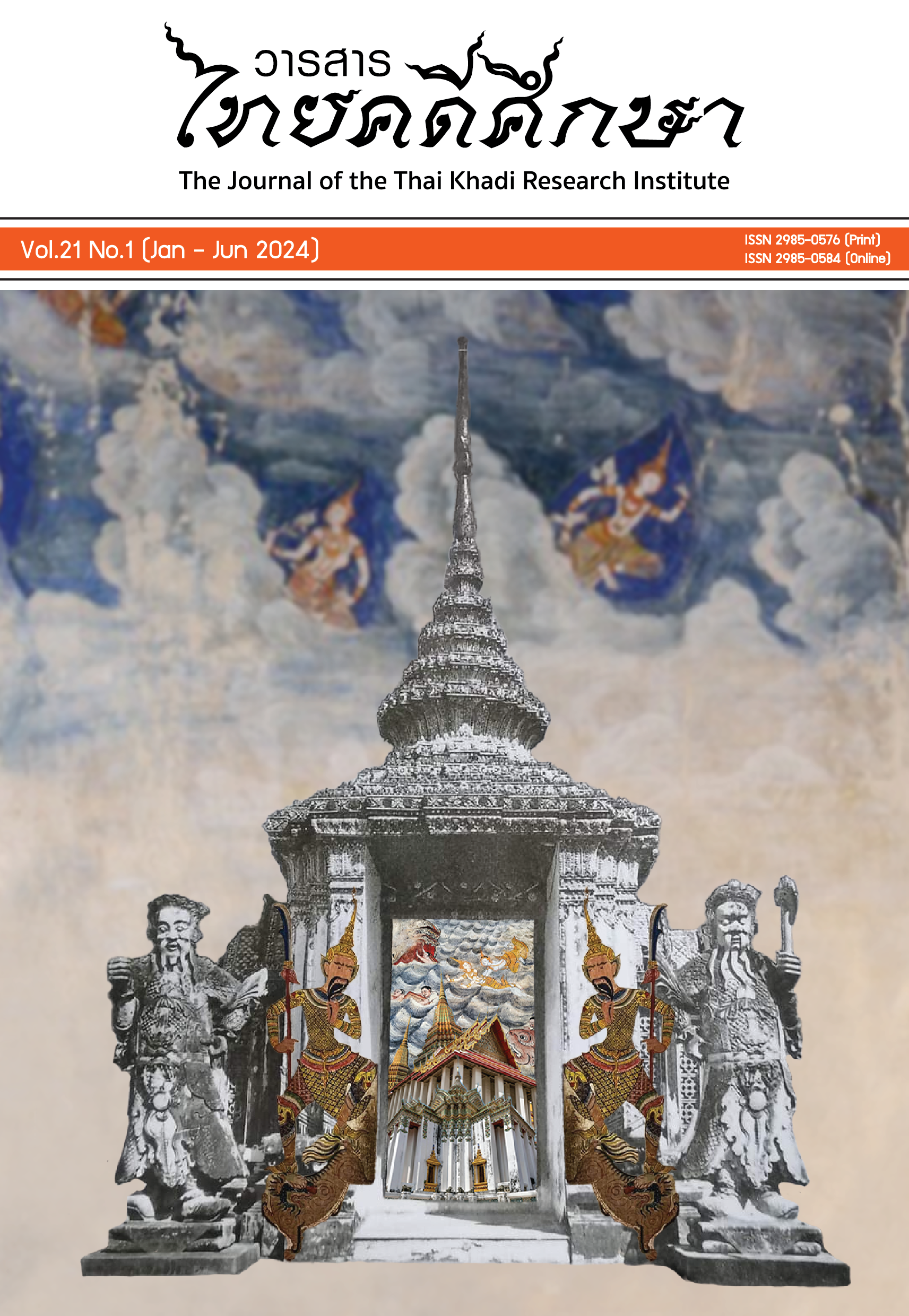Historical Writings and the Making of the Siamese Army’s Honour from the Late 1900s to the 1920s
Main Article Content
Abstract
This article explores four historical works produced by the Siamese army from the 1910s to the 1920s: Tamnan krom thahan rap thi si (History of the Fourth Infantry Regiment) (1914), Phongsawadan yutthasilpa (History of Military Strategies) (1916), Tamnan krom thahanbok rap thi nueng (History of the First Infantry Regiment, King’s Own Bodyguard) (1919), and Tamnan kan ken thahan (History of Military Conscription) (1921). Previous studies have overlooked these volumes authored simultaneously with the creation of official nationalism led by King Vajiravudh (reigned 1910-1925). Army historical writings did promoted nationalist spirit and incorporated the Siamese army into national history. The books share common themes: the sacrifice of ancient warriors and the tradition of military conscription since ancient times. This process meaningfully instilled pride and honor among soldiers and encouraged Siamese males to serve their country in the military.
Downloads
Article Details

This work is licensed under a Creative Commons Attribution-NonCommercial-NoDerivatives 4.0 International License.
There is no charge for paper processing and publication. Once the paper is under peer-review process, however, if the paper is withdrawn for any reason the author will be responsible for the expense of 3,000 Baht occurred in the review process.
References
Anderson, B. (1993). Imagined communities: Reflections of the origin and spread of nationalism, rev. ed. London: Verso.
Appointment of the National Library Committee. (1915). ราชกิจจานุเบกษา [The Royal Government Gazette], 32, 182. n.p.
Battye, N. (1974). The military, government, and society in Siam 1868 - 1910: Politics and military reform during the reign of King Chulalongkorn. (PhD. Dissertation, Cornell University).
Bhanurangsi Savangwongse, H.R.H. Krom Phraya. (1919). History of the 1st infantry regiment, King Chulalongkorn’s royal bodyguards. n.p.
Bhanurangsi Savangwongse, H.R.H. Krom Phraya. (1935). History of the 4th infantry regiment. n.p.
Boontanondha, T. (2013). King Vajiravudh and the making of his military image. (M.A. thesis Chulalongkorn University).
Bumroongsook, S. (1991). Chulachomklao Royal Military Academy: The modernisation of military education in Thailand (1887 - 1948). (Ph.D diss. Northern Illinois University).
Chakrabongse Bhuvanath Prince. (1916). History of military strategies. n.p.
Chuchaiya, K. (1985). Intellectual development of the Thai professional army, 1932 - 1981. (M.A. thesis Chulalongkorn University).
Curriculum for teaching and training soldiers. (1923). Bangkok: The department of army education.
Damrong Rajanubhab, H.R.H. Krom Phraya. (1916). History of the National Library. Bangkok: Sophonphiphatthanakon.
Damrong Rajanubhab, H.R.H. Krom Phraya. (1917). The 6th collection of chronicles: wars between Thai and Burmese since the Ayutthaya Kingdom. Printed in a cremation of a mother of Lieutenant General Phraya Siharatritthikrai 1917. Bangkok: Aksonniti.
Damrong Rajanubhab, H.R.H. Krom Phraya. (1920). A chronicle of Siamese - Burmese wars in the Ayutthaya Period. Printed in a cremation of Choachom Manda Wat in 1920. Bangkok: Thai Press.
Damrong Rajanubhab, H.R.H. Krom Phraya. (1924). Lecture on history of Siam. Bangkok: Prasoet Samut.
Damrong Rajanubhab, H.R.H. Krom Phraya. (1968). The royal autograph version of the royal chronicles. Printed in a cremation of Tailong Phonprapha on 4th September 1968.
Greene, S. (1999). Absolute dreams. Thai government under Rama VI, 1910 - 1925. Bangkok: Lotus Press.
Ketwongkot, T. (2017). History of military conscription in Thai society. Bangkok: The Friedrich - Ebert - Stiftung (FES).
Kittimahacharoen, S. (2008). “Gentleman” in the literary works of King Rama VI and Sriburapha. (PhD dissertation, Chulalongkorn University).
Koizumi, J. (2002). King’s manpower constructed: Writing the history of the conscription of labor in Siam. Southeast Asia Research, 10(1), 31 - 61.
Mahakhan, P. (1975). The military reformation in the reign of King Chulalongkorn. (Master’s thesis, Srinakharinwirot University).
Phantprasit, P. (2022). The making of honour and masculinity of the Siamese army from the 1900s to 1932. (PhD dissertation, Kyoto University).
Phumkird, S. (1995). “Asvabahu” and the use of literature for the dissemination of political thought and ideology. (Master’s thesis, Chulalongkorn University).
Pramuanwitthaya, U. (n.d.). 100 Royal highnesses and ministers. Bangkok: Khlang Witthaya.
Ratanapat, N. (1990). King Vajiravudh’s nationalism and its impact on political development in Thailand. (Ph.D. Dissertation, Northern Illinois University).
Raymond, G. (2018). Thai military power. A culture of strategic accommodation. Copenhagen: NIAS Press.
Royal Thai Army Command and General Staff College. (2010). 100 Years of the Royal Thai Army Command and General Staff College. n.p.
Sattayanurak, S. (2014). 10 Siamese intellectuals vol.1. Bangkok: Open Books.
Some historical details in the reign of King Mongkut. (1981). Printed in a cremation of Phuang Prap - angwa (Phuang Perunawin) on 4th October 1981 at Wat Somanatwihara. Bangkok: Phrae - kanchang.
Sturn, A. (2006). The king’s nation: A study of the emergence and development of nation and nationalism in Thailand. (PhD dissertation, University of London).
Sunait C. (1999). Phra Suphankanlaya: From a legend to a historical page. Bangkok: Prachachon.
Sunait C. (2013). Burma fought Thai: On warfare between Thai and Burma. Bangkok: Matichon.
Suwannachat, T. (2001). Thai military dignity under absolute monarchy, 1868 - 1932. (Master’s thesis, Srinakharinwirot University).
Tangkawanich, W. (2009). King Naresuan’s images of the Thai Court from the Rattanakosin Period to the late 1930s. Sameskybook, 7(3), 94 - 132.
The 23rd collection of chronicles: History of military conscription and history of the 4th infantry regiment. (1921). Printed on an occasion of the 4th Infantry Regiment celebration for winning the royal prize in 1921. Bangkok: Sophonphiphatthanakon.
Vella, W. (1978). Chaiyo! King Vajiravudh and the development of Thai nationalism. Honolulu: The University Press of Hawaii.
Wongwises, C. (1976). The modernisation of the royal Thai army along the western lines from 1851 - 1932. (Master’s thesis, Chulalongkorn University).


